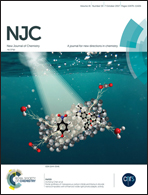A composite additive used for a new cyanide-free silver plating bath (II): an insight by electrochemical measurements and quantum chemical calculation†
Abstract
The influence of composite additives, 2,2′-bipyridine (BPY) and potassium antimonyl tartrate (PAT), on the electrochemical behavior of a 5,5-dimethylhydantoin (DMH)-based cyanide-free silver plating bath was investigated by experiments and quantum chemical calculations. The cathodic discharge process of the cyanide-free silver plating bath was studied by cyclic voltammetry (CV) and electrochemical impedance spectroscopy (EIS) measurements. CVs with different sweep rates and cathodic polarization measurements performed on a glassy carbon rotating disk electrode (GC-RDE) were employed to investigate the influence of composite additives on kinetic features of the discharge process of electroactive species. Without and with additives, the nucleation processes of silver deposition from these two electrolytes both exhibit three-dimensional progressive nucleation according to the chronoamperometry (I–t) measurements. In order to reveal the relevance between the inhibitive influence of additives and their molecular structures, the electronic properties of BPY and PAT were studied by quantum chemical calculations. The adsorption behaviors of BPY and PAT on the silver surface were further investigated by theoretical calculations and X-ray photoelectron spectroscopy (XPS). The results are in good agreement with each other, which confirms that BPY and PAT are effective additives for DMH based silver plating baths due to their ability to strongly adsorb on silver surfaces.



 Please wait while we load your content...
Please wait while we load your content...